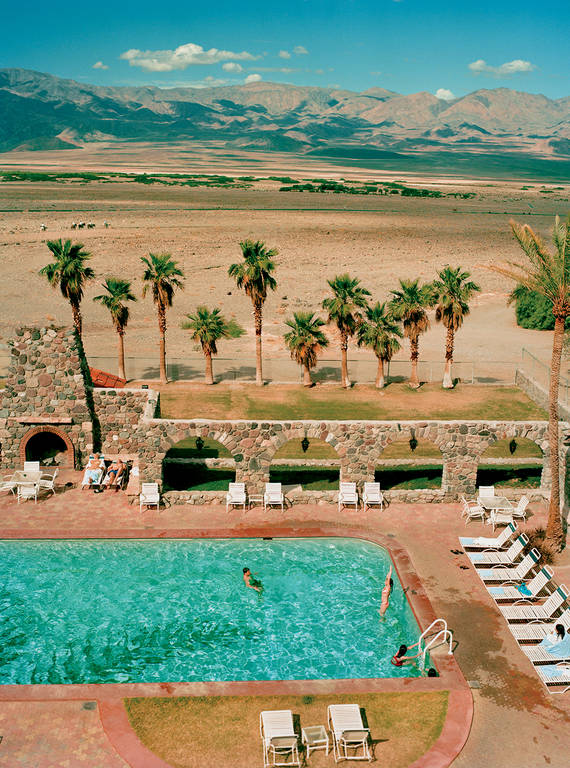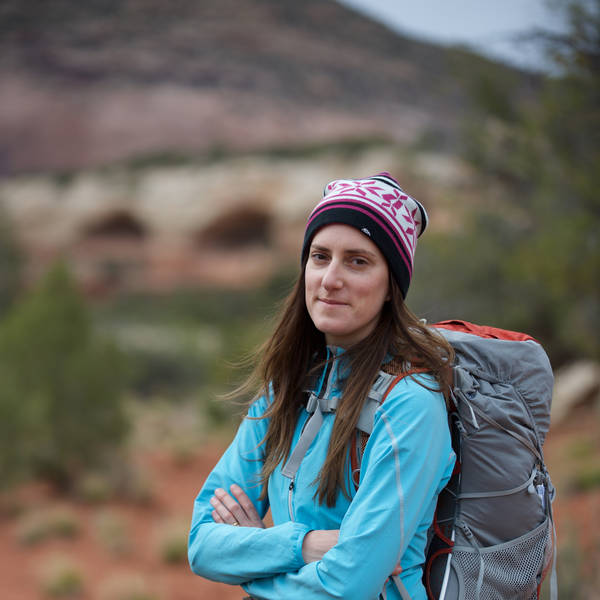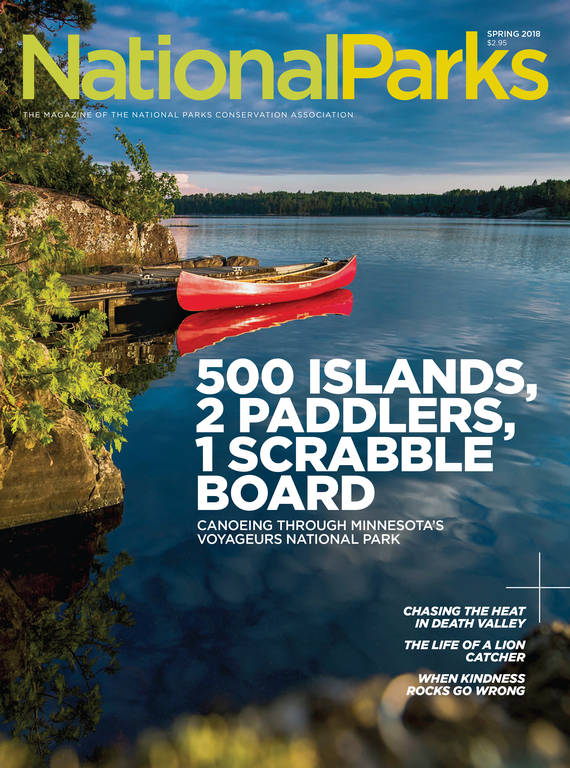Spring 2018
Some Like It Very Hot
A growing number of extreme tourists are heading to Death Valley to experience one of the hottest places on Earth at the hottest time of year.
The road into Death Valley National Park from the south snakes down more than 2,000 vertical feet through a barren landscape of geometric hills. As I descended on a late August afternoon, the reading on my car thermometer rose with alarming steadiness. 98 degrees. 105 degrees. 109 degrees. 114 degrees. When I arrived at Furnace Creek, the park’s headquarters, it was 122 degrees.
I parked in the shade, emerged from the air-conditioned sanctity of my vehicle and staggered under the press of heat. The air parched my throat, and even a slight breeze instantly dried out my eyeballs. Exposed skin felt like it was burning within minutes. I had arrived in one of the hottest places in the world during a late-summer heat wave.
For some, the hellish weather was an opportunity. Visitors snapped photographs of each other next to a digital thermometer announcing the outrageous temperature. In the staff parking lot, Isabelle Woodward, a ranger in the commercial use and permit office, pulled on leather gloves to retrieve two pans of cookies she had baked inside her sweltering car.
“Everyone looks forward to dashboard cookie day,” Woodward said cheerily as a passing ranger munched on a chewy, melty treat. The temperature was so high in her sedan that her thermometer had broken that morning. “When you move to an extreme place, you have to learn to make your own fun,” she said. “Attitude is really, really important.”
Throughout Death Valley in summer, the heat imposes itself like a fearsome deity. It’s one of the park’s great claims to renown, among its most grave dangers, and a source of awe for both visitors and residents. Ubiquitous signs warn of the hazards of overexposure at trailheads, on roadsides, next to hot playground equipment and even inside restrooms, where a diagram of urine colors identifies suitable levels of hydration. In the visitor center, a gruesome photograph of a skeleton face down in the sand illustrates the perils of dehydration.
At one time, most sane human beings avoided Death Valley in summer. The original inhabitants, the Timbisha Shoshone, migrated to higher elevations in the hot months, and in the early days of the park, founded as a national monument in 1933, visitors came only in winter. But over the last decade, August has become one of the busiest months of the year. (It was the busiest in 2014 and 2017.) Rangers say that more visitors, largely from Asia and Europe, are now coming expressly to experience one of the most extreme climates on the planet.
“If they come during a heat wave, they’ll often say, ‘I’m so lucky to be here when it’s so hot!’” said Linda Slater, who retired from her position as chief of interpretation in November. She has noticed lines of people waiting to have their pictures taken next to the visitor center’s thermometer. Without hard data, park staff can’t say exactly why there’s been an increase in extreme heat seekers but theorize that it could be the growing number of bucket-list travelers or an overall spike in tourism that’s been linked to a ballooning middle class in some Asian countries.
In July 1913, a ranch caretaker in Death Valley registered a temperature of 134 degrees and reported seeing swallows fall dead out of the sky in midflight. The accuracy of the reading has come under question in recent years but is still recognized as the hottest atmospheric temperature ever recorded. What’s certain is that Death Valley is a fiery and poignant reminder of the edges of this planet’s habitability. I came motivated by curiosity, which has led me into trouble plenty of times before. I wanted to better understand why people are drawn to such extremes and how they successfully manage to withstand — both physically and mentally —some of the most severe conditions on Earth.
“You’re going to love it!” a friend told me before I left. She has visited Death Valley many times. “But don’t face the sun or the wind, they’ll shear your face off.” She paused for effect. “And watch out for the metal on your sunglasses. It’ll burn you.” What had I gotten myself into?
One afternoon during my three-day visit, I drove out to Badwater Basin, the lowest point in North America at 282 feet below sea level. This wide, flat, shimmering valley heats up so much because a belt of peaks cycles rising hot air down to the valley floor to be cooked again. It also lies in the rain shadow of four mountain ranges. As I drove, the landscape appeared to undulate from the heat. The few plants that live here are so parched they turn beige like the sand. Creosote bushes, with their tiny leaves and desperately deep roots, are one of the only plants that can survive on the edges of the stark white salt flats.
Park rangers recommend staying outside for a maximum of 15 minutes during the hot season. “This time of day, I’d say 70 to 80 percent of visitors at the park are dehydrated,” Woodward had told me the day before. It was 113 degrees when I exited my car, and I was surprised to find that, despite the inhospitable conditions, I was far from alone. Travelers, lined up in a tidy row as if they’d been choreographed, posed for selfies. Some carried umbrellas for shade, while others ventured into the sunshine bare-shouldered. I was sweating profusely but felt dry because every drop of moisture evaporated instantly.
In the distance, the warmth bent the light so much that the white salt appeared like a roiling whitewater river, and I realized with a shiver what it’s like to be deceived by a mirage. Within about 10 minutes of walking, my heartbeat quickened, my head felt tight and woozy, and I started to feel the dark bloom of panic. At the same time, the landscape captivated me with its unique austerity. The tonal simplicity felt almost surreal, as if I were suspended in a world drawn by a primitive hand.
Later, at Devil’s Golf Course, a field of knee-high salt formations, I lasted only about three minutes before diving into my car, soggy and tomato-faced. Meanwhile, I watched a man I met from the Florida Keys pad about for what seemed an interminably long time as I held my face a few inches from the air-conditioning vent. It seems some people actually love and appreciate the heat — or at least tolerate it. Every year in July, a hardy — or one might say insane — group of runners trot from Badwater Basin to Mount Whitney, the tallest peak in the contiguous U.S. They often run on the white line of the road because it’s a smidge cooler than the blacktop. In October, cyclists gather in the park for a 100-mile bike ride despite temperatures that often hover in the 90s.
I was surprised to find that many people I met hadn’t actually given the heat much thought. They came because they had vacation time or they were headed to cooler climes, such as Yosemite, Sequoia and Kings Canyon National Parks, and decided to stop by Death Valley on their way. Their cavalier attitudes might explain why, despite the signs, visitors regularly get into heat-related trouble.
“Most people know that heat is a danger, but they don’t know how fast it can be a danger,” said Kevin Ross, emergency services coordinator for the park. Each year, the search and rescue team responds to about 180 medical calls, mostly related to dehydration and heat exhaustion, and performs about a dozen rescue missions. Many visitors, particularly motorcyclists, run into difficulty on the park’s 800-plus miles of backcountry roads. But it’s not uncommon for car-driving visitors who are simply sightseeing to underestimate the need for water and get dangerously dehydrated. In 2014, a French man on a bus tour wandered a bit too far out into the dunes on a short break and became lost. Park staff immediately launched a search and found him within four hours, but he had already died. It was 117 degrees in the parking lot.
For the nearly 300 people who live here in the park — largely National Park Service and concessioner staff — the intensity of the living conditions breeds the sense of camaraderie people develop when undertaking great challenges. Often groups of staffers play board games on summer weeknights when it’s too hot to venture outside (some nights, it never drops below 100 degrees) and head to the mountains en masse for a brief respite of cool on weekends. Some brave souls defy the elements and play a standing volleyball game once a week in the evening.
Jan VanderLey, who works at one of the Death Valley hotels and volunteers at the park during his free time, thought he was “going to die” when he moved here two years ago during an October heat wave. “Now, I actually love it,” he said.

Seeking refuge from the heat in the pool at the Inn at Death Valley.
© INTERSECTION PHOTOS/ALAMY STOCK PHOTOHe’s used to the quirks of living in the valley: Tap water flows hot no matter which faucet you use, and many people keep gloves with them at all times to avoid burns from car-door handles and black gas pumps. The clothes I pulled from my suitcase, fresh out of the trunk of my car, felt like they just came from a hot dryer, and even in the hotel pool at the Ranch at Death Valley — where many visitors find refuge during broiling afternoons — my uncovered head roasted.
But staying in the valley, I also began to understand that people had come for more than the heat. One morning, I struck up a conversation with a visitor from Berlin and asked him what brought him here.
“The heat, yes, but the second time, we came for the landscape,” he said. “It’s really simple. There’s heat, stone and silence. In a world with so much built up, this is hard to find.”
TRAVEL ESSENTIALS
Those who live here happily maintain a healthy fear of the heat and find ways to adapt. (Woodward claims that despite growing up in New England, after living in Death Valley for nearly a decade, she now dons a sweater when it’s below 80 degrees.) A key part of their success lies in appreciating this place for what it is: a Mars-like hinterland marked by beautiful extremes. I decided to follow their examples and set about enjoying Death Valley’s singular character. I watched sunrise at Zabriskie Point, a lookout point over crenellated hills striped crimson and beige. I drove through the great expanses of desert, stayed up late watching the stars and lolled in the pool, taking in the giant sky along with other visitors escaping the heat. Before dawn, I hiked up Golden Canyon and sat in the 92-degree stillness as the barest traces of life started to reveal themselves. An elegant dragonfly. A wispy moth.
Naturally, as the planet warms, Death Valley is growing hotter, too. The area hasn’t topped the 1913 record, but since the early 1900s, when recordkeeping began, the average maximum and minimum temperatures have trended upward. Last June, temperatures in the park hit record highs for the date five times. In July, the average temperature in the park was 107.4 degrees. That meant it was the hottest month ever recorded on Earth, according to the Washington Post. As climate change comes to Death Valley, precipitation patterns may change, increasing the possibility of flash floods, and animals may start moving into higher elevations as their habitats become too warm. Staff have little information on the likely effects, but University of California Berkeley scientists are overseeing a multiyear study comparing findings on current wildlife population distribution and animal body size to similar research conducted between the 1910s and 1940s.

National Parks
You can read this and other stories about history, nature, culture, art, conservation, travel, science and more in National Parks magazine. Your tax-deductible membership donation of $25 or more entitles…
See more ›Surprisingly, experiencing firsthand some of Earth’s hottest weather didn’t make me hopeless about our steamy future, but rather, I felt motivated to protect the delicate habitability of this planet. I also felt grateful for the opportunity to witness these extraordinary conditions. One evening at sunset, I walked out into the Mesquite Dunes with some water and a journal. I sat down on the hot, hot sand in a breeze that felt like the exhaust from a dryer vent. My head ached from my perpetually losing battle with dehydration, but the land was so boldly gorgeous, minutes passed when I actually forgot about the heat.
The mountains glowed in the sunset light, and storms bruised the sky. A porcelain half-moon rose behind me. It was so quiet I could hear only the wind rushing over my ears. As night turned the sky, peaks and dunes into hundreds of shades of blue, smoldering pink veins of lightning illuminated everything for just a moment.
About the author
-
 Kate Siber Contributor
Kate Siber ContributorKate Siber, a freelance writer and correspondent for Outside magazine, is based in Durango, Colorado. Her writing has appeared in National Geographic Traveler and The New York Times. She is also the author of “National Parks of the U.S.A.,” a best-selling children’s book.


